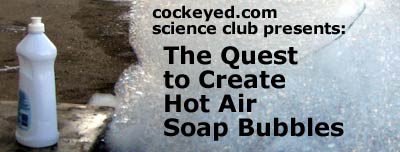

 |
|
 |
After a pint-sized success making helium-filled soap bubbles in October, I got the idea that I might be able to repeat their performance with another lighter-than-air component - hot air. Among the many letters I received after making flyaway soap bubbles with helium, Russ Newsom had a story: Hi, Rob, I haven't annoyed you (or entertained - who knows?) in a while, but helium bubbles brought back a memory from my days as a tech in the oil & gas well drilling biz. You might be interested. |
Utilizing our clothes dryer was my first idea. The exhaust isn't properly vented outside, so it was easy to pick it up and drop it into a bucket. The end of the hose needed to be submerged, but it was fighting, pushing against the surface of the water. Weighed down with a rock, the escaping air slowed to a burble and stopped. The air pressure seemed robust in open air, but there was no way it could blow past 4 or five inches of water.
|
|
I puzzled over a quick way to keep the exhaust hose at the perfect depth - deep enough to blow actual bubbles, but shallow enough to allow air to escape. I did not come up with anything right away. Aaaand, as an unexpected consequence of this experimentation. I blew the thermal fuse in the dryer. My self-inflicted airflow blockages had resulted in overheated heating elements. The thermal fuse melted, knocking the dryer heat offline. Kind of like how a hair dryer will stop working if you stop it from blowing, only this was permanent. I guess this is a good thing, since this system was designed to stop house fires, but I didn't realize what I had done until later, AFTER the new Kenmore had arrived. |
My next plan for hot air bubbles was to boil water, and to force the hot steam down and into a reservoir of bubble fluid. I was sure. SURE this would work. This was my "obviously, this will work" plan. However, I couldn't do it inside, and my only outdoor cooking source was a barbeque grill. A small-scale test was in order. With a thrift store teapot and a length of plastic aquarium air hose, I had a sure-fire bubble machine. I would need to securely fasten the top to the teapot, but wasn't sure how to go about it. I was a little worried that I was creating a bomb. But! The bubbles weren't making much impact on the surface. The bubbles were cooling down in the target cup, cooling so much that they returned to their liquid state before they broke through the surface. Hm. I hadn't expected this. Maybe the target cup had to be filled with hot water too.
|
My third plan for harnessing a free source of hot gas was to hook up a hose to our car. After all, when you have already ruined your clothes dryer, why not start experimenting with your car? The exhaust pipe was next, and I was somewhat more successful harnessing its power. With a 140 HP engine, I figured the Hyundai could bubble up though a few inches of bucket soap. And I was right. |
Using the black plastic hose from our pool toy air pump, coupled with a makeshift flange from a broken flashlight, I routed the exhaust into a 5 gallon bucket of water. I was a little shy about doing this outside in the front yard, because it had a rather suicidal look to it. |
|
Again weighed down by a rock, air had to push a few inches of water out of the way. No problem. The air blew up into a volcano of water and air. Water went everywhere.
|
|
please continue reading page 2 of The Quest to Create Hot Air Soap Bubbles page 1 2 3 4 |
Discovering new Velcro Closures with the Eyeclops | Details of Different Types of Knitting Yarn | Reader contributions for the Eyeclops | How much is inside Thread Count?contact Rob | how much is inside a
keg | height weight chart |
how much is inside goldschlager |
backwash | Cash4Gold | work from home overload
science club | pranks |
How much is inside? |
Home |
Incredible Stuff I Made | Car Rollover | Traffic Court
February 13, 2009.